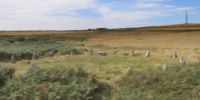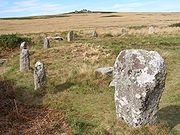
Tregeseal East stone circle
Encyclopedia

Stone circle
A stone circle is a monument of standing stones arranged in a circle. Such monuments have been constructed across the world throughout history for many different reasons....
around one mile northeast of the town of St Just
St Just in Penwith
St Just is a town and civil parish in Cornwall, England, United Kingdom. The parish encompasses the town of St Just and the nearby settlements of Trewellard, Pendeen and Kelynack: it is bounded by the parishes of Morvah to the north-east, Sancreed and Madron to the east, St Buryan and Sennen to...
in Cornwall
Cornwall
Cornwall is a unitary authority and ceremonial county of England, within the United Kingdom. It is bordered to the north and west by the Celtic Sea, to the south by the English Channel, and to the east by the county of Devon, over the River Tamar. Cornwall has a population of , and covers an area of...
, United Kingdom
United Kingdom
The United Kingdom of Great Britain and Northern IrelandIn the United Kingdom and Dependencies, other languages have been officially recognised as legitimate autochthonous languages under the European Charter for Regional or Minority Languages...
. The nineteen granite stones are also known as The Dancing Stones. It is the one surviving circle of three that once stood aligned along an east-west axis on the hillside to the south of Carn Kenidjack.
Location
The stone circle is in southwest CornwallCornwall
Cornwall is a unitary authority and ceremonial county of England, within the United Kingdom. It is bordered to the north and west by the Celtic Sea, to the south by the English Channel, and to the east by the county of Devon, over the River Tamar. Cornwall has a population of , and covers an area of...
east of the road from Morvah
Morvah
Morvah is a civil parish and village on the Penwith peninsula in west Cornwall, United Kingdom. The village is situated approximately eight miles west-southwest of St Ives and 5½ miles north-west of Penzance....
to St Just in Penwith
St Just in Penwith
St Just is a town and civil parish in Cornwall, England, United Kingdom. The parish encompasses the town of St Just and the nearby settlements of Trewellard, Pendeen and Kelynack: it is bounded by the parishes of Morvah to the north-east, Sancreed and Madron to the east, St Buryan and Sennen to...
and is approximately one kilometer east of the village of Tregeseal.
Construction

Granite
Granite is a common and widely occurring type of intrusive, felsic, igneous rock. Granite usually has a medium- to coarse-grained texture. Occasionally some individual crystals are larger than the groundmass, in which case the texture is known as porphyritic. A granitic rock with a porphyritic...
blocks with a height between 1.0 and 1.4 m, which describe an approximate circle
Circle
A circle is a simple shape of Euclidean geometry consisting of those points in a plane that are a given distance from a given point, the centre. The distance between any of the points and the centre is called the radius....
with a diameter of around 21 m. Two stones are probably missing, since the circle consisted of 21 stones in earlier times. The stone circle was subjected over the centuries to substantial rebuilding and restoration work, so that today only the stones in the eastern half of the circle may be in their original positions.
The stone circle was part of a larger ritual area, which, like the area around The Merry Maidens
The Merry Maidens
The Merry Maidens , also known as Dawn's Men is a late neolithic stone circle located 2 miles to the south of the village of St Buryan, in Cornwall, United Kingdom....
, consisted of three stone circles in an east-west alignment. The other two stone circles were to the west of the existing stone circle. The westernmost of the three circles is today only detectable on aerial photographs. Of the middle stone circle, which originally had the largest diameter and contained ten stones in 1885, today only a single stone is to be found standing.
History
Stone circles such as that at Tregeseal, were erected in the late NeolithicNeolithic
The Neolithic Age, Era, or Period, or New Stone Age, was a period in the development of human technology, beginning about 9500 BC in some parts of the Middle East, and later in other parts of the world. It is traditionally considered as the last part of the Stone Age...
or in the early Bronze Age
Bronze Age
The Bronze Age is a period characterized by the use of copper and its alloy bronze as the chief hard materials in the manufacture of some implements and weapons. Chronologically, it stands between the Stone Age and Iron Age...
by representatives of a Megalithic culture. The first mention of the stone circle in the modern times is found in the 1754 work Antiquities, historical and monumental, of the County of Cornwall by William Borlase
William Borlase
William Borlase , Cornish antiquary, geologist and naturalist, was born at Pendeen in Cornwall, of an ancient family . From 1722 he was Rector of Ludgvan and died there in 1772.-Life and works:...
, who reported 17 upright standing stones. An early drawing, by William Cotton
William Cotton
William Cotton may refer to:* William Cotton , American artist and playwright* William Cotton , Bishop of Exeter, 1598–1621* William Cotton , Governor of the Bank of England, 1842–1845...
in 1827, can be found in his book Illustrations of Stone Circles, Cromlehs and other remains of the Aboriginal Britons in the West of Cornwall. At that time some of the standing stones in the other stone circles were still visible. William Copeland Borlase
William Copeland Borlase
William Copeland Borlase FSA was an antiquarian and Liberal politician who sat in the House of Commons from 1880 until 1887 when he was ruined by bankruptcy and scandal....
reported 15 stones in his work Naenia Cornubia of 1872, and showed the exact location of the stones.
See also
Other prehistoric stone circles in the Penwith district- Boscawen-UnBoscawen-UnBoscawen-Un is a Bronze age stone circle close to St Buryan in Cornwall, UK. It consists of 19 upright stones in an ellipse with diameters 24.9m and 21.9m, with another, leaning, stone just south of the centre. There is a west-facing gap in the circle, which may have formed an entrance. It is...
- The Merry MaidensThe Merry MaidensThe Merry Maidens , also known as Dawn's Men is a late neolithic stone circle located 2 miles to the south of the village of St Buryan, in Cornwall, United Kingdom....
- also known as Dans Maen - BoskednanBoskednan stone circleBoskednan stone circle is a partially restored prehistoric stone circle near Boskednan, around 4 miles northeast of the town of Penzance in Cornwall, United Kingdom...
- also known as the Nine Maidens of Boskednan
Further reading
- John Barnatt: Prehistoric Cornwall. The Ceremonial Monuments. Turnstone Press Limited, Wellingborough 1982, ISBN 0-85500-129-1.
- Ian McNeil Cooke: Standing Stones of the Land's End. Men-an-Tol Studio, Cornwall 1998, ISBN 0-9512371-9-5.
- Robin Payne: The Romance of the Stones. Alexander Associates, Fowey 1999, ISBN 1-899526-21-8.
External links
- Tregeseal East stone circle site page on The Megalithic Portal
- Tregeseal Dancing Stones & Carn Kenidjack site page on The Modern Antiquarian

